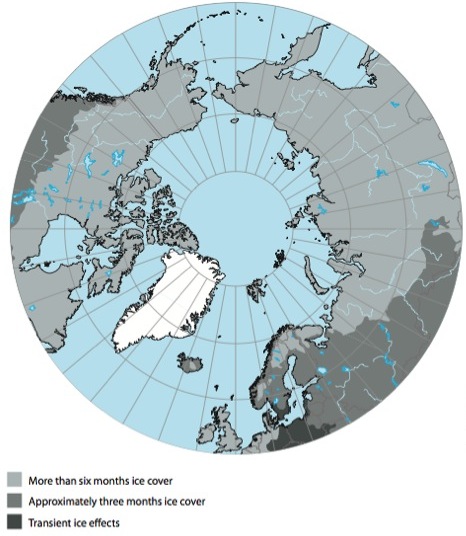
temperature isotherm (SWIPA, 2011).
On an annual basis, many Arctic river systems go through an open water season, followed by freeze-up, ice growth and break-up. This seasonal process varies depending on the size and depth of the river system. Rivers that are shallower and smaller tend to freeze-up more readily and rapidly than larger, deeper river systems. Additionally, systems with slower water movement allow more continuous and undisturbed ice growth, in comparison to fast moving river systems. The seasonal process of river ice is dependent on geographic location and climate. As seen in Figure 1, generally higher latitude regions experience longer river ice cover than lower latitude regions. The events characterizing river ice regime are discussed below (SWIPA, 2011).
Freeze-up
The process of freeze-up in Arctic river systems begins between late autumn and early winter. If the river is slow moving, large thin sheets of ice are able to form. In contrast, if the river is quite moving, small shards of frazil ice are formed first. Frazil ice is small ice particles that are able to grow in dynamic water systems, as the water begins to loose heat to the surrounding, cooling atmosphere. These small particles of frazil ice eventually grow into larger ice pans. These pans continue to accumulate until they create an ice blockage across the river channel. This process allows even more ice to accumulate into the ice mass. This blockage reduces upstream flow, allowing river ice to form more quickly in that area. This initial ice blockage may break several times before the river ice is stable (SWIPA, 2011).
Ice Growth
The initial river ice developed continues to grow across the river system horizontally, and into the river depths vertically. If a river system is sufficiently shallow, the entire water column may freeze over. In contrast, some rivers allow under ice flow to continue during the winter – this allows some organisms to remain in the river perennially. During ice growth, snow can accumulate on top of the river. In some cases, this snow acts as an insulator, reducing the cooling of the water and subsequently decelerating ice growth. In some cases, snow accumulation can weigh down the ice, bringing underlying water to the surface. This water successively refreezes on the surface, creating snow ice (SWIPA, 2011).
Break-up
The break-up of river ice in the spring occurs in multiple stages. As the atmosphere begins to warm, the surficial snow melts on the river ice. This loss of snow reduces the insolating properties of the system, allowing the warm atmosphere to interact with the river ice surface. Ice break-up continues at the water-ice interface, allowing flow to begin or continue at a higher rate. This accelerated water flow mechanically breaks up the overlying ice mass. As ice concentration is reduced, the surface absorbs more solar radiation, melting more ice in a positive feedback loop. Eventually, the river system becomes ice-free. At this point in the spring, water levels and river discharge peak (SWIPA, 2011).
An ice jam is an accumulation of broken ice which restricts or blocks the flow of water. Ice jams form when the volume of moving ice exceeds the transport capacity of the river. This can occur due to channel narrowing, sharp bends in the river, or when the ice meets an obstacle such as a bridge or a strong intact ice cover. Upstream of an ice jam, water levels may increase to high levels and cause severe flooding. When the jam is released, a steep water wave, a "jave", progresses downstream, resulting in flooding, breaking of downstream ice covers and potential damage to infrastructure. The severity of the break-up and ensuing ice jam is dependent upon the water levels during the preceding freeze up, the thickness of the ice cover at the end of the winter, the weather condition during the breakup period, the water velocity and the spring runoff (Beltaos, 2008). Ice-induced floods have lower recurrence than open water floods but cause larger damage. For example, in New Brunswick (Canada), ice-jam induced flooding accounts for 42% of all floods, but they are responsible for almost 70% of the flood damages (Humes and Dublin, 1988).


dates (Philippe Rekacewicz, UNEP/GRID-Arendal).
Click figures for larger images.
Geographical Variation
The seasonal process of river ice freeze-up and break-up varies across the Arctic. Generally, freeze-up occurs earlier in the year at northernmost latitudes (Figure 2a), and later as latitude decreases. Maritime climates often influence this process as seen in the Canadian west coast. River systems in this region freeze much later (January) than the rest of the Arctic. A similar trend occurs in northeastern Quebec. Additionally, break-up of river ice occurs in a similar way (Figure 2b), with higher latitude regions breaking up the latest. The maritime influence is visible in this process as well, with west coastal regions of Canada and the Alaska having river ice break-up dates much sooner (March) than other regions.
Material on this page was provided by Maren Pauly, Department of Geography, University of Waterloo. Hover over photographs for image credit.
